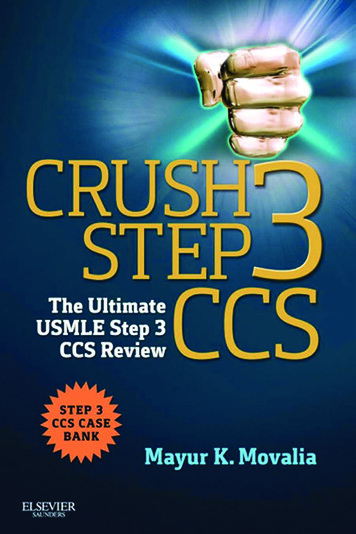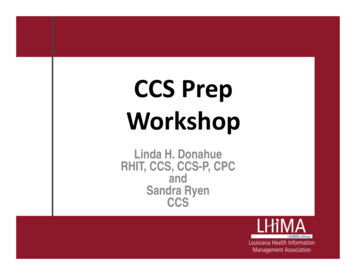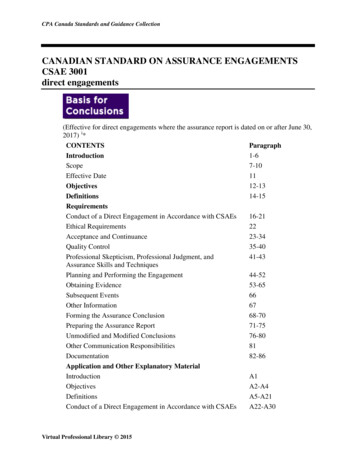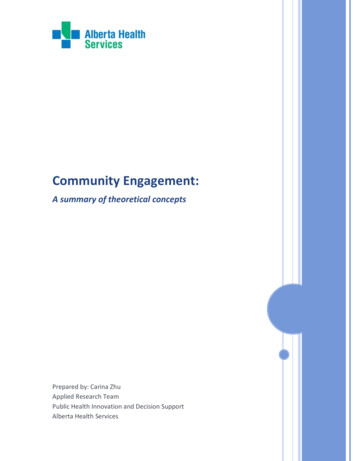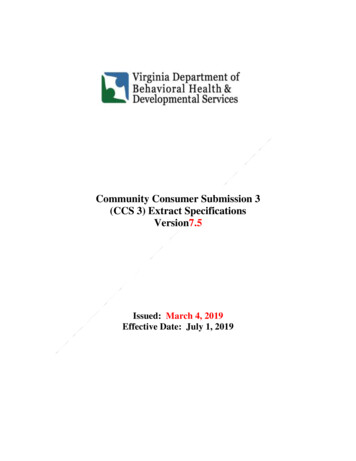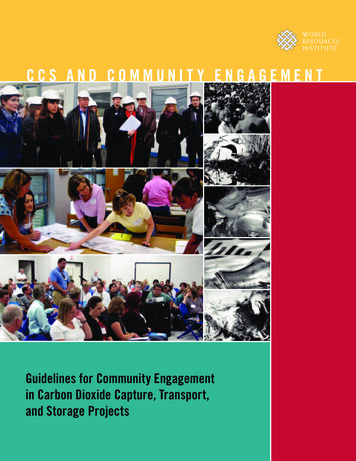
Transcription
1CCS AND COMMUNIT Y ENGAGEMENTGuidelines for Community Engagementin Carbon Dioxide Capture, Transport,and Storage Projects
CONTRIBUTORSJason Anderson, World Wildlife FundCameron McQuale, GeogreenShannon Anderson, Powder River Basin Resource CouncilGeorge Minter, Hydrogen Energy InternationalScott Anderson, Environmental Defense FundBrian Moody, Tuscola Economic Development Inc.Anni Bartlett, Cooperative Research CentreRuth Mourik, Energy Research Centre of the Netherlandsfor Greenhouse Gas TechnologiesBrendan Beck, International Energy Agency GreenhouseGas R&D ProgrammeMarjolein Best-Waldobher, Energy Research Centreof the NetherlandsJeffrey M. Bielicki, University of MinnesotaCorinne Boone, Hatch Ltd.Mark A. Northam, University of WyomingKaren R. Obenshain, Edison Electric InstituteGeorge Peridas, Natural Resources Defense CouncilAnthony Pleasant, Coles TogetherTheresa Pugh, American Public Power AssociationJohn Quigley, Pennsylvania Departmentof Conservation & Natural ResourcesJudith Bradbury, Pacific Northwest National LaboratoryDarlene Radcliffe, Duke Energy CorporationKevin Bryan, Meridian InstituteJoe Ralko, IPAC-CO2Cynthia Coleman, General Electric CompanyTiffany Rau, Hydrogen Energy InternationalSteven Crookshank, American Petroleum InstituteDan Riedinger, Edison Electric InstituteDaniel J. Daly, University of North DakotaAshleigh Hildebrand Ross, ConocoPhillips CompanyHeleen De Coninck, Energy Research Centre of the NetherlandsNorm Sacuta, Petroleum Technology Research CentreTim Dixon, International Energy Agency GreenhouseJudith Shapiro, Carbon Capture & Storage AssociationGas R&D ProgrammeChristopher Short, Global CCS InstituteSarah Edman, ConocoPhillips CompanyHelen Silver, Clean Air Task ForceRichard Esposito, Southern Company GenerationChris Smith, Environmental Defense FundC.F.J. (Ynke) Feenstra, Energy Research CentreGary Spitznogle, American Electric Power Service Companyof the NetherlandsAndrea Feldpausch, Texas A&M University SystemTony Steeper, Cooperative Research Centrefor Greenhouse Gas TechnologiesEmily Fisher, Edison Electric InstituteJennie C. Stephens, Clark UniversityLauren Fleishman, Carnegie Mellon UniversityAmanda Stevens, New York State EnergyLori Gauvreau, Schlumberger Carbon ServicesResearch and Development AuthorityLinda Girardi, Eastern Research GroupJonathan Temple, The Bellona FoundationSallie E. Greenberg, Illinois State Geological SurveyKirsten S. Thorne, Chevron CorporationAngela Griffin, Coles TogetherLindsey Tollefson, Montana State UniversityJosh Habib, Cadmus Group Inc.Paul Upham, University of ManchesterIan Havercroft, University College LondonSarah Wade, AJW Inc.Ken Hnottavange-Telleen, Schlumberger Carbon ServicesLuke Warren, Carbon Capture & Storage AssociationGretchen Hund, BattelleAnn Weeks, Clean Air Task ForceScott Imbus, Chevron CorporationElizabeth J. Wilson, University of MinnesotaElsa Johnston, University of ReginaSteve Winberg, CONSOL EnergyRobert Kane, U.S. Department of EnergyRudra Kapila, University of EdinburghVincent Kientz, ENEA ConsultingJeremy Kranowitz, The Keystone CenterKalev Leetaru, University of IllinoisGretchen Leslie, Pennsylvania Departmentof Conservation & Natural ResourcesWRI AUTHORS AND EDITORSMaha Mahasenan, Hydrogen Energy InternationalSarah M. ForbesSarah Mander, University of ManchesterFrancisco AlmendraSean T. McCoy, Carnegie Mellon UniversityMicah S. Ziegler
CCS AND COMMUNIT Y ENGAGEMENTWRI
2AcknowledgmentsDisclaimerThis publication is the collective product of a carbon dioxideThis report was designed to provide guidance to CCS projectcapture and storage (CCS) stakeholder process convened bydevelopers, regulators, and local communities as they engagethe World Resources Institute (WRI) between April 2009 andin discussions regarding potential CCS projects. The report hasOctober 2010. The unique perspectives and expertise thatbeen developed through a diverse multistakeholder consultativeeach participant brought to the process were invaluable toprocess involving representatives from business, nongovern-ensuring the development of a robust and broadly accepted setmental organizations, government, academia, local economicof community engagement guidelines for CCS. In addition to thedevelopment bodies, and other backgrounds. While WRIinsights provided by the stakeholders, additional perspectivesencourages the use of the information in this report, its applica-were added through the peer review.tion and the preparation and publication of documents basedWe would like to thank each of the stakeholders (listed on theinside front cover of this report) for generously contributingtheir time and expertise to this effort, as well as the WRI peerreviewers (Phil Angell, Stephanie Hanson, Kirk Herbertson,individuals who contributed to the report assume responsibilityfor any consequences or damages resulting directly or indirectlyfrom their use and application.Lalanath de Silva, and Jake Werksman) and the external peerThe Guidelines reflect the collective agreement of the contrib-reviewers (Peta Ashworth, Albane Gaspard, Andrew Gilder, Kristuting stakeholders, who offered strategic insights, providedHetland, Kai Lima, Tezza Napitupulu, Willy Ritch, Ethan Schutt,extensive comments on multiple iterations of draft guidelinesWalter Simpson, Tony Surridge, and Catherine Trinh) for theirand technical guidance, and participated in several workshopsthoughtful review of the document prior to publication.and conference calls. The authors and editors strived to incor-This report would not have been produced without the leadershipof WRI Climate and Energy Program Director Jennifer Morgan,and the authors and editors who demonstrated outstandingcommitment and diligence throughout the process. This workand the stakeholder process also benefited substantially fromthe strategic insights and reviews of WRI staff members RuthGreenspan Bell and Janet Ranganathan. We are thankful for theearly contributions to this initiative by former WRI staff membersDebbie Boger, Holly Elwell, Alex Grais, Jennie Hommel, JenniferLayke, Yue Liu, Suejung Shin, and Preeti Verma. We are thankfulto the many WRI staff who helped this process run smoothlyin many ways, notably Hyacinth Billings, Stacy Kotorac, KevinLustig, Ashleigh Rich, and Oretta Tarkhani. We are also gratefulto Polly Ghazi, Emily Krieger and Alston Taggart for their carefulCCS COMMUNITY ENGAGEMENTon it are the full responsibility of its users. Neither WRI nor theediting, copyediting, and design work.Lastly, but importantly, WRI would like to thank RobertsonFoundation, Energy Foundation, and United Kingdom Foreignand Commonwealth Office for their financial support.porate these sometimes diverse views. In so doing, they weighedconflicting comments to develop guidelines that best reflect theviews of the group as a whole, and acknowledged divergingopinions among stakeholders. Although the Guidelines reflectthe collective input of the contributing stakeholders, individualstakeholders were not asked to endorse them. The identificationof the individual stakeholders should not be interpreted as, anddoes not constitute, an endorsement of the Guidelines by any ofthe listed stakeholders or their organizations.
3RegulatorsLocal DecisionmakersProject DevelopersCCS COMMUNITY ENGAGEMENTGuidelines for Community Engagementin Carbon Dioxide Capture, Transport,and Storage Projects
CONTENTS4FOREWORD7CCS COMMUNIT Y ENGAGEMENT GUIDELINES : OUR PROCES S8E XECUTIVE SUMMARYCCS and Climate Change Mitigation10Community Engagement in the CCS Context10About the Guidelines11GUIDELINES GROUPED BY AUDIENCE13GUIDELINES FOR REGUL ATORS13n UnderstandLocal Community Context13Information about the Project13n E xchangen Identifythe Appropriate Level of Engagement14n DiscussPotential Impacts of the Project14n ContinueEngagement Throughout the Project Life Cycle14GUIDELINES FOR LOCAL DECISIONMAK ERS15n UnderstandLocal Community Context15Information about the Project15n E xchangen Identifythe Appropriate Level of Engagement15n DiscussPotential Impacts of the Project15n ContinueCCS COMMUNITY ENGAGEMENT10Engagement Throughout the Project Life Cycle16GUIDELINES FOR PROJECT DEVELOPERS17n Understand Local Community Context17nExchange Information about the Project17nIdentify the Appropriate Level of Engagement17nDiscuss Potential Impacts of the Project17nContinue Engagement Throughout the Project Life Cycle18Chapter 1: Introduction19CRI T IC A L ROL E OF HO S T-COM MUNI T Y S UP P OR T FOR CC S20ABOUT THIS REPORT22AUDIENCE22COMMUNIT Y ENGAGEMENT IN THE CCS CONTEX T24Effective CCS Community Engagement25Direct Decisionmaking Roles for Community Members26Indirect Decisionmaking Roles for Community Members27Community Engagement Timeline28
5Chapter 2: CCS-specific Issues for Community Engagement29STATUS OF CCS TECHNOLOGY30CCS REGUL ATIONS AND PERMIT TING PROCESS33TIMELINE OF A REPRESENTATIVE GEOLOGICAL CO2 STOR AGE PROJECT331. Site Selection342. Project Plans and Construction353. Operation354. Closure and Post-Injection Monitoring365. Post-closure Stewardship36Chapter 3: Leveraging Experience from Other Industries and CCS Projects37T EN WAYS COMMUNIT Y ENG AGEMEN T CA N FAIL38CASE STUDY EXPERIENCE FROM CCS RESEARCH AND DEMONSTRATIONS40C A S E S T U DY #1 :Barendrecht CCS project—Barendrecht (the Netherlands)41C A S E S T U DY # 2 :Wallula Project—Wallula, Washington (USA)42C A S E S T U DY # 3 :FutureGen—Mattoon, Illinois (USA)43C A S E S T U DY # 4 :CO2CRC Otway Project—Nirranda, Victoria (Australia)47C A S E S T U DY # 5 :Jamestown Oxycoal Project—Jamestown, New York (USA)49C A S E S T U DY # 6 :Carson Hydrogen Power (CHP) Project—Carson, California (USA)51CASE STUDY EXPERIENCE : COMMON THEMES AND LESSONS52Chapter 4: Guidelines for CCS Community Engagement53F I V E K E Y P R I N CI P L E S O F E F F E C T I V E C O M M U N I T Y E N G A G E M E N T F O R C C S541. U N D E R S T A N D L O C A L C O M M U N I T Y C O N T E X T54Guidelines for Understanding Local Community Context2. EXCHANGE INFORMATION ABOUT THE PROJECT575858Access to Information59Processes for Exchanging Information60Quality and Level of Detail of Information62Guidelines for Exchanging Information about the Project633. IDENTIFY THE APPROPRIATE LEVEL OF ENGAGEMENT65Guidelines for Identifying the Appropriate Level of Engagement4. DISCUSS POTENTIAL IMPACTS OF THE PROJECT6869Understanding Potential Impacts70Discussing Risks Effectively75Guidelines for Discussing Potential Impacts of the Project765. CONTINUE ENGAGEMENT THROUGHOUT PROJECT LIFE CYCLEGuidelines for Continuing Engagement Throughout the Project Life Cycle7778CCS COMMUNITY ENGAGEMENTTypes of Information
6Chapter 5: Supplementary Information79A PPENDIX 1: E XIS TING LEGA L FR A ME WORK S FOR PUBLIC PA RTICIPATION IN SELECT COUN T RIES A ND REGIONS80China80European Union80United Kingdom80United States81APPENDIX 2: REFERENCE LIST FOR PUBLIC AT TITUDES ON CCS82Media82Nongovernmental Organizations (NGOs)82Public Attitudes in Different Countries83Reports84Surveys84APPENDIX 3 : K E Y REFERENCES ABOUT THE TECHNOLOGY AND IT S ROLE IN ADDRES SING CLIM ATE nprofit85Science86Universities87APPENDIX 4 : OTHER POTENTIAL REFERENCES AND TOOLSCCS COMMUNITY ENGAGEMENT82General88Impact Assessment88Regulations, Rulemaking, and Other Government Resources88Other88G L O S S A R Y, A C R O N Y M S , A N D A B B R E V I A T I O N S89NOTES93PHOTOGRAPHY CREDITS96Rendition of the CCS process chain by a student from Linlithgow Academy, Scotland (another student illustration is located on page 37).
Foreword7TThere is no single quick fix or technological silver bullet that will reduce thegreenhouse gas emissions that are altering the Earth’s climate. Rather, a range oftechnologies and strategies will need to be employed to keep global temperature risebelow the 2.7 degrees Fahrenheit danger threshold identified by scientists.Some of these solutions (think energy efficiency or wind and solar power) are triedand tested, but need scaling up; others are emerging and not yet commercially available,but offer great potential. Carbon dioxide capture and storage or CCS falls into the lattergroup. A suite of technologies that together can be used to sequester carbon dioxidegreenhouse gas emissions from power stations and other major industrial sources, CCSis now moving from demonstration projects to commercial scale pilots.Most credible analyses project a key role for CCS as a bridging technology betweentoday’s fossil fuel–based global economy and the low carbon societies of tomorrow.To be effective in helping contain global emissions, however, CCS deployment wouldneed to accelerate dramatically over the next three decades, which is where communityengagement, the subject of this report, comes in.As an emerging technology which involves injecting carbon dioxide intogeologic formations, CCS has drawn wary reactions from some communities aroundthe world where demonstration projects have been sited or proposed. Too often, thereaction from regulators, project developers and local authorities has been to viewpublic opinion and local communities as a barrier to technology deployment. Thisreport takes the opposite tack: it starts from the position that project developers andregulators should treat host communities as partners whose questions and concernscan improve the project and who should be consulted in the design, development andoperation of CCS projects on their doorstep.To be clear, this report does not aim to make a case for or against CCS. Instead, itoutlines how local communities can help shape decisionmaking around CCS projects,and in so doing build wider public support for the emerging technology.The report builds on WRI’s previous consensus-building stakeholder effort, whichresulted in the publication of the Guidelines for Carbon Dioxide Capture, Transport,and Storage, a technical guide for CCS projects. This complementary publication isthe product of the collective experience and best thinking of more than 90 experts andstakeholders involved in CCS across the world, including academics, project developers,regulators, nongovernmental organizations and community groups.The resulting conclusions are intended to serve as international guidelines forregulators, local decisionmakers (including community leaders, citizens, local advocacygroups, and landowners) and project developers as they plan and seek to implementexperience gained integrated into a revised edition of globally-applicable best practices.Whether CCS will be viable at commercial scale is yet to be proven. Withoutpublic buy-in, however, the chances are slim that the technology will be deployed atmeaningful scales for climate change mitigation. Transparency and consultation areprerequisites for this buy-in.WRI hopes this report will provide a basis for best practice engagement on CCSprojects worldwide, which will help enable the public to judge the technology on itsown merits.Jonathan LashPresident, World Resources InstituteCCS COMMUNITY ENGAGEMENTCCS projects. The guidelines will be road tested with CCS projects in the field, and the
CCS COMMUNITY ENGAGEMENT GUIDELINES:OUR PROCESS8This World Resources Institute (WRI) report provides guidelines for local communityengagement and public involvement in carbon dioxide capture and storage (CCS)projects. The report does not aim to make a case for or against CCS. Instead, it outlineshow local communities, particularly those living or working near a potential carbondioxide (CO2) storage site, should be included alongside project developers and regulators as key parties in any proposed CCS project, and how such communities can proactively help shape engagement and decisionmaking processes.The Guidelines is the product of a stakeholder process convened by WRI and is based onthe participants’ collective experience, as well as the latest developments in CCS researchand deployment efforts. The Guidelines proposes how to effectively engage local communities during CCS project planning, development, operation, and long-term stewardship.The Guidelines will be road tested in real-life CCS projects, and the experience gained willbe integrated into a revised edition of globally-applicable best practices for CCS projects.Stakeholder Group: Contributors to the Guidelines have experience studying andpracticing community engagement for CCS projects in different countries and provide arange of perspectives. The group includes academics, project developers, governanceexperts, representatives from utility and fossil energy companies, public servants involvedin both policymaking and regulation, community representatives, scientists, and nongovernmental organization (NGO) representatives. Most contributors’ names and organizational affiliations are listed on the inside front cover. Some stakeholders requested thattheir names be withheld, as they were not officially authorized to contribute by theirrespective organizations (notably regulators from governmental agencies involved withCCS). Such contributions were still fully considered and appreciated.It is important to note, however, that it is challenging to create a perfectly balanced stakeholder group. In relation to CCS, particular difficulties included reflecting the voices ofthose so opposed to the technology that they would rather not join the discussion, andthose who might only speak out if a CCS project were actually proposed in their specificcommunities. Finally, it is difficult to convene a geographically balanced set of stakeholders that would both enhance and inform the Guidelines. WRI’s approach to dealingwith these challenges was to introduce missing perspectives in a rigorous peer-reviewprocess that followed the stakeholder deliberations. The peer-review group includedexternal experts both in support of and in opposition to CCS as a technology, leadersof local opposition to real CCS projects, and experts and public servants from countriesCCS COMMUNITY ENGAGEMENTcurrently considering CCS regulations and research endeavors.Approach: The Guidelines avoids providing a step-by-step methodology for community engagement because each CCS project and community is unique and requires anengagement process tailored to suit site-specific needs.The Guidelines primarily focuses on the aspects related to the CO2 storage phase of CCS,such as very long time horizons, rights to subsurface usage, and the potential impactson local communities from CO2 injection, from both a technical and a socioeconomicperspective. This approach aims to shed light on some of the unique needs for publicengagement on CCS, as the stakeholders found that engagement around capture andtransport is generally similar to that which already occurs for other power, industrial, andinfrastructure installations. However, all phases of a project will need to be taken intoconsideration as these principles are put into practice in communities. For example, the
9source of CO2 for a proposed storage project may significantly influence the way theproject is perceived by the host community: a project that intends to build a new coalfired power plant as the source of CO2 may be viewed very differently by a communitythan a project that intends to retrofit an existing plant.The Guidelines builds on WRI’s previous 2-year consensus-building stakeholdereffort, which resulted in the publication of the Guidelines for Carbon Dioxide Capture,Transport, and Storage, a technical guide for how to responsibly proceed with CCSprojects.1 Although this report includes a brief overview of CCS, readers shouldconsult the technical guidelines for detailed information on CCS technology and itsuse. The guidelines presented here also draw on and adapt WRI’s research on community engagement related to extractive industries in developing countries, whichidentified seven principles for effective community engagement: 21. Prepare communities before engaging.2. Determine what level of engagement is needed.3. Integrate community engagement into each phase of the project cycle.4. Include traditionally excluded stakeholders.5. Gain free, prior, and informed consent.6. Resolve community grievances through dialogue.7. Promote participatory monitoring by local communities.The stakeholders have made an effort to focus on general, transferable principles forcommunity engagement and participation as opposed to focusing on any specificexisting regulatory scheme.Audience and Objective: Groups and parties that may be engaged in the decisionmaking process for CCS projects encompass governments, national environmentalgroups, various project developers, CCS researchers, and other stakeholders. However,this report focuses on local community engagement, with the local community definedas the collection of citizens of one or more towns/cities/counties living near a project whomay potentially be directly affected by one or more of its components. Engagement withnonlocal parties, while also important, lies outside the scope of this effort.The Guidelines provides practical recommendations for integrating local input and involvement into potential CCS projects. Communities not only have a right to be included, but theirengagement is also important to the successful deployment of CCS as a climate mitigationstrategy at a large scale. Experience has shown that insufficient community involvementcan hinder CCS deployment. Not all proposed CCS projects will move forward, and manywill be opposed by local communities for valid reasons. Thus, realizing the public-goodpotential of CCS-generated climate mitigation will require establishing trusting, respectful,Because of the evolving debate and experience surrounding CCS and the unique natureof each local community and CCS project, the Guidelines stops short of defining adecisionmaking process to determine whether specific CCS projects should proceed.Instead, the Guidelines aims to strengthen the underlying process so that the community,developers, and regulators are all effectively represented in the decisionmaking.Likewise, while the guidelines support the seven WRI engagement principles outlinedabove, they do not explicitly prescribe any binding dispute settlement procedures orformally endorse Free, Prior, and Informed Consent (FPIC) in a CCS context (see boxon page 39). These decisions stem from the stakeholder process, and do not reflect achange in WRI’s stance on governance issues.CCS COMMUNITY ENGAGEMENTand stable relationships among project developers, regulators, and local communities.
10EXECUTIVE SUMMARYCCS and Climate Change MitigationCarbon dioxide capture and storage (CCS) encompasses a suite of existing andemerging technologies for capture, transport, and storage of carbon dioxide (CO2) thattogether can be used to reduce the greenhouse gas emissions from fossil fuel powergeneration and other industrial sources. Achieving cuts in energy-related CO2 emissionsis critical to avoiding more than a 1.5 degree Celsius ( C) (2.7 degree Fahrenheit [ F])rise in global temperatures by 2050 and the irreversible and damaging impacts sucha temperature rise would have on people and ecosystems.3 The scale of the climatechange challenge requires a portfolio of clean energy technologies and energy efficiencyefforts, and most credible analyses project that CCS will have to play a substantial rolein achieving the necessary emissions reductions (see Appendix 3).CCS has been tested at a small scale, and there are a few industrial operations aroundthe world, including in North America and Europe, which already capture and storesmall quantities of CO2 emissions underground. However, the technology has not yetbeen demonstrated at the scale required for application to commercial power andindustrial plants. To address this gap, governments of many major economies haveannounced plans to support commercial-scale CCS demonstration projects that storemore than 1 million metric tons of CO2 annually.4 Several are currently being built inEurope, China, Australia, and Canada, and many more are in the planning stages,including in the United States. Leading industrial nations, through the G8, have calledfor 20 such demonstration plants to be launched by 2010, with a view toward broaddeployment by 2020.5Actions taken to demonstrate transformational clean energy technology over thenext decade will define the solutions available to help solve the climate problem.6Commercial-scale CCS demonstration projects are required to demonstrate whether ornot the technology should play a major role in bridging today’s fossil fuel–driven worldand tomorrow’s low- or zero-carbon economy. Yet, as with the introduction of manynew technologies, proposed CCS projects have been met with mixed reactions fromthe public, and in particular from the local communities asked to host them.Community Engagement in the CCS ContextProject developers and technical experts in CCS often cite the public as a “barrier”to CCS deployment, because decisions on whether individual projects move forwardCCS COMMUNITY ENGAGEMENToften significantly depend on the local community’s acceptance or opposition. Thecase studies from the United States, the Netherlands, and Australia featured in thisreport suggest that communities often have more concerns and questions about CCSthan about more established industries and technologies. The guidelines for community engagement, however, were written with the belief that decisions on individualdemonstration projects ultimately hinge on site-specific factors, including the needsof the local community. While much social science research around CCS to datehas focused on gauging public attitudes toward the technology or on education andoutreach best-practices for project developers (see Appendix 2), we focus instead onproviding recommendations for creating a culture of effective, two-way communityengagement around CCS projects.
11In addition to project developers and host communities, there is a third partner essential to effective community engagement around CCS: regulators. In some countries,regulatory frameworks governing CCS development and deployment, including rules forcommunity engagement, are already in place (see Appendix 1). In others, an environmental regulatory framework for CCS does not yet exist, and the advent of demonstration plants is forcing regulatory policymakers to make real-time decisions about how toensure projects move forward safely, and what level of public participation should berequired in the decisionmaking processes.The engagement around any one project, therefore, is contingent on the interactions ofthree primary groups: local decisionmakers (typically on behalf of those in the community), regulators, and project developers. All three groups are addressed in this report.It is important to underscore upfront, however, that effective community engagementis measured by the success of the engagement process, and is not contingent uponagreement between the project developer, regulator, and community on the outcomeor the design of the CCS project. Nevertheless, effectively engaging communitiescan help move CCS projects forward and foster continuing constructive relationshipsbetween project developers and communities. Such relationships can help ensurethat commercial-scale CCS demonstrations and any subsequent commercial projectsprogress in such a way that local economies, values, ecosystems, and people arerespected, and the potential of the technology in helping to mitigate climate change isfully realized.About the GuidelinesThe Guidelines was drafted by authors at WRI in close consultation with an internationalgroup of stakeholders (see inside front cover) with specific expertise and experiencein engaging local communities regarding deployment of CCS technology. This effortbuilds on WRI’s previous 2-year consensus-building stakeholder effort that resulted inthe Guidelines for Carbon Dioxide Capture, Transport, and Storage, a set of technicalguidelines for how to responsibly proceed with safe CCS projects.7 The communityengagement guidelines for CCS are intended to serve as international guidelines forregulators (including those in both regulatory policy design and implementation capacities); local decisionmakers (including community leaders, citizens, local advocacygroups, and landowners); and project developers to consider as they plan and seek toimplement CCS projects.The Guidelines begins with an introduction that describes their intent, a working definition of community engagement, and why effective engagement is an essential elementof CCS deployment. It then provides an overview of relevant CCS technology issues,timeline and various stages of a representative CCS project. The report then reviewsexisting relevant experience in community engagement, presented in six case studiesfrom CCS projects. These studies were drafted by stakeholders engaged in the development of the Guidelines who had a hands-on role either in engaging the local community or in decisionmaking around the featured project. Chapter 4 of the report presentsthe guidelines for community engagement on CCS.CCS COMMUNITY ENGAGEMENTincluding the status of CCS technology, regulatory and permitting processes, and the
12Key Principles in CCS Community Engagement and Roles for Each Party in the ProcessContinue Engagement through TimeLearn communityEducate, respondEstablish aRequire communi-Require publicconcerns. Determine,to, and providemultistakeholdercation and contingencyparticipation at keyinformation toengagement process.measures and regularstages and increaseimprove publicthe public.REGULATORSDiscuss Risks andBenefits of Projectmeet, and possiblyLOCAL DECISIONMAKERSExchange Information Identify Appropriateabout the ProjectLevel of EngagementUnderstandPROJECT DEVELOPERSUnderstand LocalCommunity ContextAssess communityEng
CASE STUDY #6: Carson Hydrogen Power (CHP) Project—Carson, California (USA) 51 CASE STUDY EXPERIENCE: COMMON THEMES AND LESSONS 52 Chapter 4: Guidelines for CCS Community Engagement 53 FIVE KEY PRINCIPLES OF EFFECTIVE COMMUNITY ENGAGEMENT FOR CCS 54 1. UNDERSTAND LOCAL COMMUNITY CONTEXT 54 Guidelines for Understanding Local Community Context .


